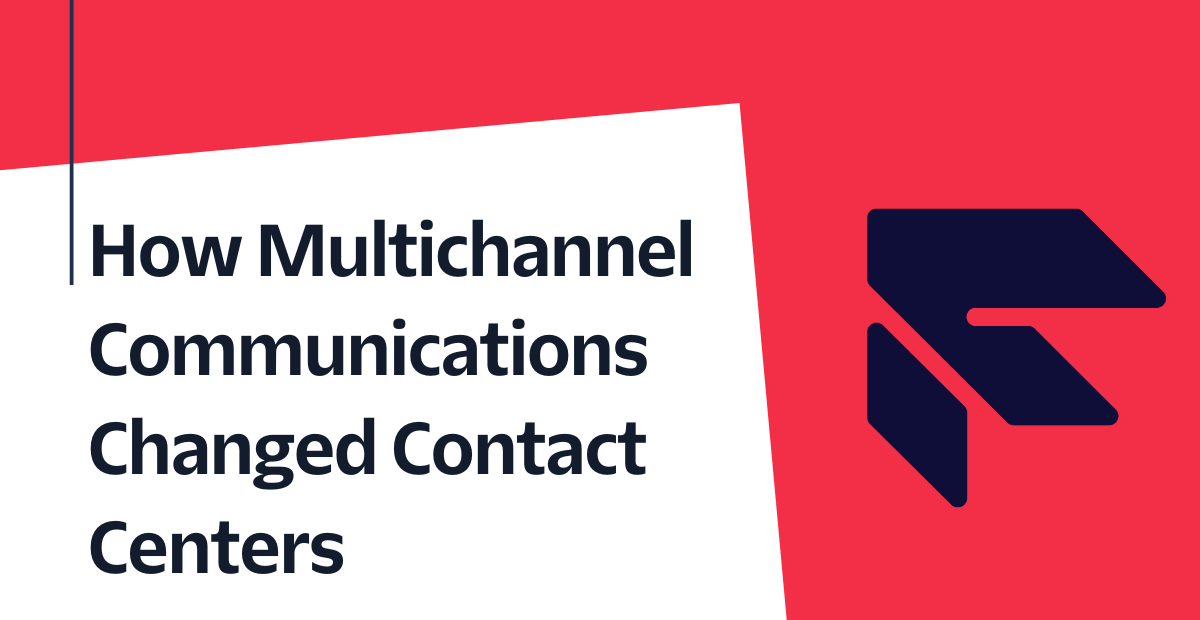How Multichannel Communications Changed Contact Centers
Time to read: 4 minutes

Picture this: you’re scrolling through a social media app on your phone while half-browsing Netflix for something to watch on your TV and doing your taxes on your computer. Then, someone tries calling you.
If your first instinct is to reject the call, you’re not alone—today’s consumers are all digital, all the time. That’s why to meet shifting standards for customer service, your organization’s contact centers must evolve past what outdated call centers can provide.
Your customers deserve a comprehensive, multichannel communications approach that shows you're ready to help them overcome their challenges wherever they are—whether mobile, web, chat, or email. Read on to learn why multichannel messaging platforms have become the modern standard and how to transition your legacy call center over to a modern cloud-based contact center.
Why are legacy call centers still in use?
The time for digital transformation at contact centers is now, but the reality is that outdated call centers are still the typical approach for many organizations. Here's why:
- Legacy tech experience: Existing staff tend to dislike the idea of learning new technology because they fear negative impacts to their productivity.
- Tricky data transfers: Reliable access to customer data is crucial for your agents to effectively service your customers. But legacy call centers with outdated technology tend to store customer data in many formats and locations, which makes it difficult to collate customer data in preparation for the transfer.
- Expensive transition process: Once you commit to switching over to multichannel communications, the transition itself is a time-and-budget-intensive process. Without access to a dedicated suite of tools that streamlines the data transition, your tech teams will likely spend considerable resources developing a proprietary approach.
Signs you need to transition to a multichannel messaging platform
If any of the mentioned challenges have deterred your organization from using multichannel messaging platforms, consider these 5 compelling reasons.
- You want to offer customers new ways to get in touch—but your tech architecture won’t support them.
- Your current systems are slow—and get slower as you onboard new agents, acquire new customers, and attempt to add new communications channels.
- Your maintenance costs are high—and getting higher.
- You audit your tech stack for security—and realize your organization and your customers are potentially at risk.
- Your tech documentation is lacking—and many documents are misplaced, so agents can’t quickly access them to help customers.
3 ways to bridge gaps between cloud-based contact centers and your customers
So you’ve decided to transition your legacy call center over to a multichannel messaging platform. You’ve made a great, forward-thinking choice.
Now, it’s time to make the switch a reality. Here are 3 actions you can take to effectively convert your legacy call center over to a cloud-based contact center solution that bridges gaps between you and your customers.
1. Embrace new communications channels as the technology emerges
The march of new technology is unending. There will always be new services and hardware that upend the ways your customers communicate with friends and family, which will influence how they want to reach you. When your contact center has the latest communication channels, your customers will feel more incentivized to engage with your organization’s offerings.
2. Bring multichannel communications together into one convenient view
One challenge many call center agents face is a lack of immediate access to the data necessary to help customers as quickly as possible. For example, if a customer calls their internet provider multiple times in a week to receive assistance with slow, inconsistent internet service, it’s helpful for agents to be able to view information such as the customer’s prior recorded internet speeds and their service plan.
But to do so, an agent may need to spend time sifting through their email inboxes or even digging through file cabinets for the right paper. Also, what if a different agent who last worked with that customer has the data on their work machine—which may be at another of your contact center locations—so the customer’s information is effectively locked?
Situations like these—which should be easy to navigate—end up damaging your relationship with your customer and your organization’s reputation due to lengthy hold times and insufficient results.
Streamlining your communications efforts into a singular digital view enables you to provide customers with better contact center experiences. Suddenly, all your phone transcriptions, text and webchat logs, and emails become instantly available to your agents in just a few simple clicks, making employee workflows easier and customers happier.
3. Leverage a contact center API that minimizes development overhead
Contact center APIs are a great way to onboard new digital communication channels to your organization. When your entire tech team works with the same core function library, it’s much easier to build the robust architecture necessary for integrating new and emerging digital communications channels into your contact center.
These fully featured contact center APIs can empower your developers by creating more gratifying omnichannel customer experiences. Great APIs also double as cloud-based contact center solutions, helping all your agents and locations stay connected and to your customers.
Unify your contact center with Flex One API
The Flex One API from Twilio provides a software-driven solution that accelerates the process of adding new digital channels to your organization’s contact center. With it, you can enable SMS, MMS, webchat, WhatsApp, and native email to engage with your customers wherever they are—all from one convenient location and fully customizable on a per-team basis.
If you’re ready to convert your legacy call center into a streamlined, state-of-the-art, cloud-based contact center, continue reading to learn more about Flex and the Flex One API from Twilio. Then, have your multichannel messaging platform’s tech teams take a look at this comprehensive and convenient Flex contact center API documentation reference to get started. If you’d like more support, you can always contact an expert.
Related Posts
Related Resources
Twilio Docs
From APIs to SDKs to sample apps
API reference documentation, SDKs, helper libraries, quickstarts, and tutorials for your language and platform.
Resource Center
The latest ebooks, industry reports, and webinars
Learn from customer engagement experts to improve your own communication.
Ahoy
Twilio's developer community hub
Best practices, code samples, and inspiration to build communications and digital engagement experiences.


